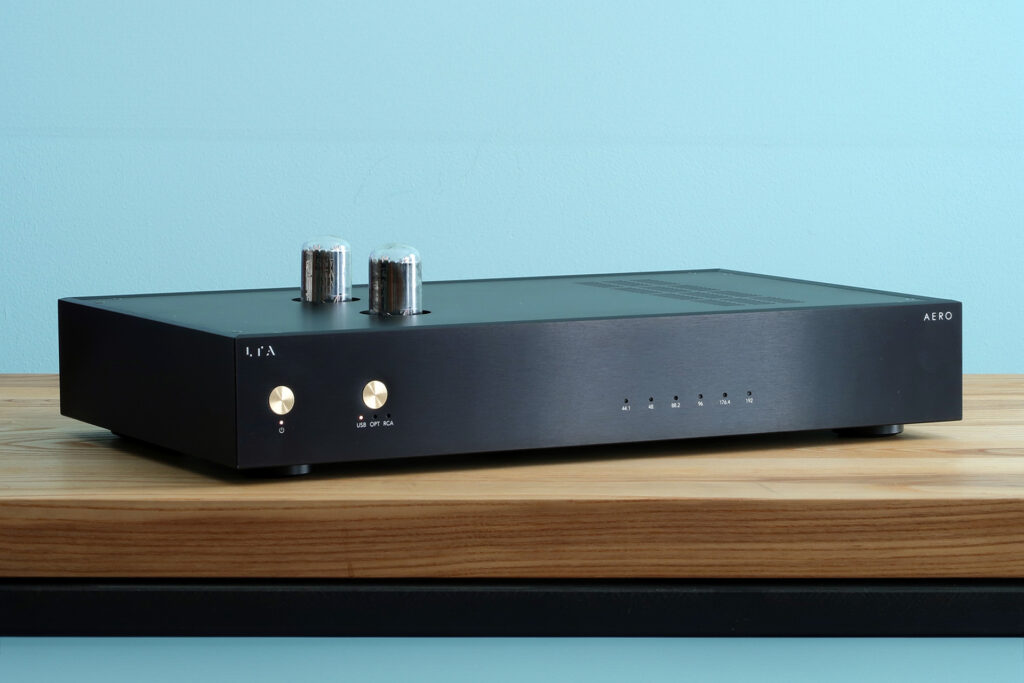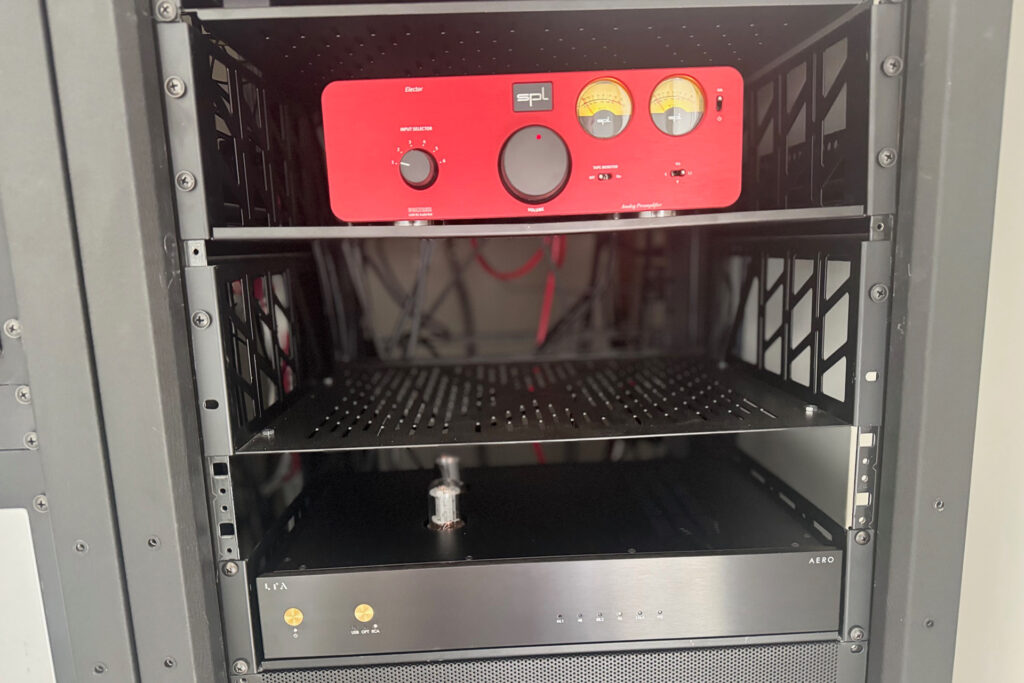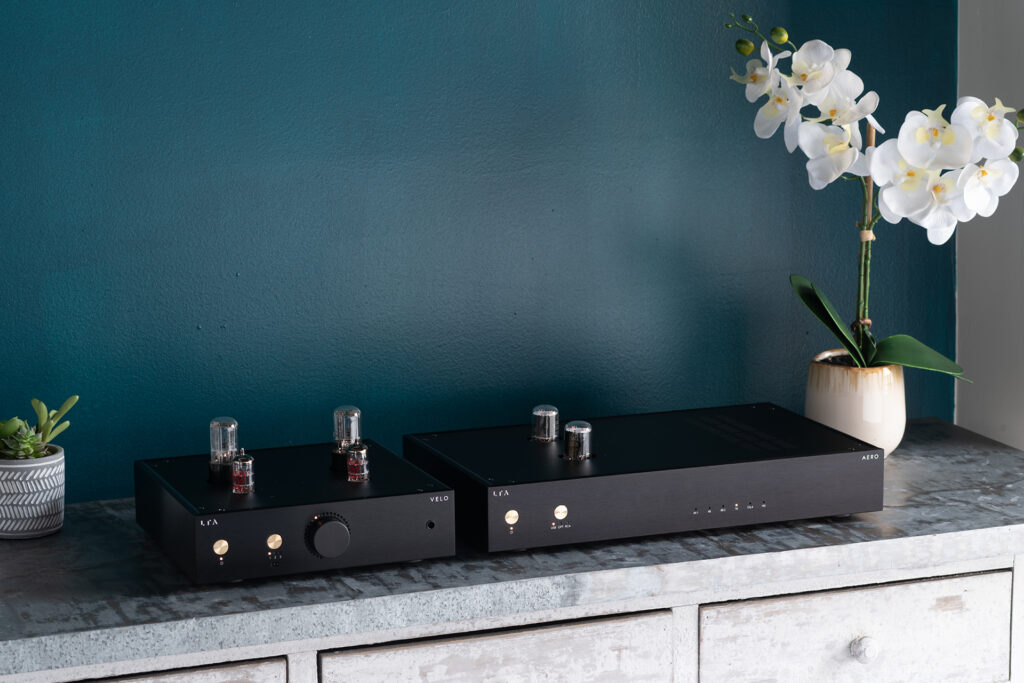Much like the FutureAudiophile.com crew, Linear Tube Audio’s team tends to attend the best regional audiophile shows all over the continent. Nicholas and his team are a fun-loving group of guys, and their audiophile-grade hotel room demos always sound notably good without being anywhere close to what one would consider expensive by audiophile standards. The most compelling product in their current product lineup is an audiophile component that has just gotten inside of my head. LTA makes a $3,950 digital-to-analog converter that uses David Berning’s Class-A ZOTL technology to add a tube to the output stage to ever-so-gently soften the sonic harshness that sometimes is associated with digital audio playback. The next detail that blew my mind is that Linear Tube Audio sought out a vintage Analog Devices NOS (NOS: “not on sale” to some and “new old stock” to others) DAC chip. This isn’t some bleeding-edge, modern ESS Sabre chip. This is a vintage DAC chip from a long-gone era of digital playback. That is a zag in a world full of zigs.
Every bit of my audiophile snobbery wanted to reject this entire component before even listening to it. But I resisted, even if I could taste the blood from biting my tongue. The idea that an audiophile manufacturer wouldn’t use the latest, sine-wave-perfect DAC chip(s) is enough to fry my mental circuity. The idea that an engineer would add a tube to the output stage of the DAC again is antithetical to getting as close to the master tape concept that I so believe in. Then I went to another show (Capital Audiofest in Bethesda, Maryland), and I reported that the LTA and MCAudioTech room was the absolute best-sounding setup at the show. Once again, this Aero DAC was at the heart of the glorious-sounding system. Could I put aside my preconceived opinions? I am a professional – so of course I can. So, I ordered up a review sample that arrived at Christmastime, which was a pretty cool present to open to start off the holidays. How did the DAC sound compared to the murderers’ row of DACs in my audiophile rack? That’s what you read our reviews for, right?

What Makes the Linear Tube Audio Aero DAC So Special?
- The LTA Aero DAC is the perfect digital audio component for the vinyl lover. While I might be one of them, not everybody wants to sonically go over speed bumps in a Lamborghini. It can be just a little too rough and jarring for some. The LTA Aero DAC is smooth like Barry White, but not bloated or congested-sounding whatsoever, as you might stereotypically expect from mid-level tube gear. The use of a tube in the LTA DAC’s output stage just takes a little zip out of the digital zingers that I was finding on my BlueSound Node 2024 streamer from time to time.
- The power supplies in this LTA DAC are the type that an enthusiast would spec into a truly robust audiophile component. And when did a digital component not benefit from a beefy, serious business power supply? That’s a solid NEVER in the history of the audiophile hobby. LTA spent on the power supply, and that really does help the overall performance of the digital audio component. The design is inspired by David Berning’s PRE-ONE power supply and keeps a lot of power in reserve.
- The tubes never need to be shut off, as they last close to forever before needing to be retubed – unlike other, more demanding tube-based components like power amps. Literally, I’ve never left a tube product on in my equipment rack like this, but the LTA Aero never hiccupped or even got hot.
- The amount of effort that went into hand-curating the tubes that go into the Linear Tube Audio Aero DAC also screams: designed by an enthusiast. The LTA team took a lot of time looking for just the right flavor of tubes to use on their output stage. They didn’t want to muck up the sound as much as just take out some of the digital harshness or hash via an analog approach. This might not match up with my philosophy on how to design an audiophile system, but this product marches to the beat of its own drummer.
- The build quality of the LTA Aero DAC is robust. This is no audiophile project box, chunk of garbage. This is a solidly-made, well-crafted audiophile component worthy of being installed in a top-performing system.
- Setup couldn’t be simpler with the LTA Aero DAC. I had the box open and music playing, including unpacking, as well as installing the tubes, in maybe 10 minutes. By the way, even the boxes are luxurious, which isn’t always the case at this price point.
- You can run the LTA Aero balanced, which is rare for a tube product. I used single-ended outputs for most of my listening for logistical reasons. I was using new WireWorld Series 10 digital cables and analog interconnects.
- The LTA Aero DAC comes with a three-year warranty and a 30-day in-home trial, as most buy Linear Tube Audio products direct.
- There are three digital inputs on the Linear Tube Audio Aero DAC: COAX, USB and Optical. I skipped USB, as I think it is a noisy connection. I used COAX for most of my listening tests.
Why Should You Care About the Linear Tube Audio Aero DAC?
The Compact Disc was launched in 1983, when I was nine years old. I had a player soon after the format’s release, thus my music collection was (and still is) almost exclusively digital. This isn’t always the typical path for an audiophile, and for somebody who is looking for an ever-so-slightly warm-sounding, inviting, plays-well-with-other-components DAC, this might be just the ticket for you.
With audiophile components getting more and more complex and, in many cases, more and more integrated, the Linear Tube Audio DAC allows an easy to use and easy to upgrade component that has a lot of appeal. Would it be crazy for a tube enthusiast to have a few different varieties of tubes on hand? Why not? They aren’t that expensive and, in this type of design, they last a long time. Is one tube better than another? I can’t really tell you, as that would spoil the fun for those looking to explore with tube upgrades. This isn’t a DAC that I would expect to see in a recording studio, but I would expect an audiophile who might love vinyl or likes vintage audio to be enthralled.

Some Things You Might Not Like About the Linear Tube Audio Aero DAC
- The concept that one would seek out a vintage DAC chip still blows my mind. The goal of any DAC chip is to reproduce the zeros and ones in a way that is as perfectly analogous to the source as possible. Today’s DAC chips are basically perfect. I am not sure that older ones can claim such technical performance. Then again, that very revealing “in-the-studio” sound is what many audiophiles don’t like about high-end digital playback. The Linear Tube Audio Aero is solving a different problem or appealing to a different potential client.
- The LTA Aero DAC is Roon-ready, but that comes with costs and some complications. I spent some time playing with Roon in late 2024, but Brian Kahn really put a lot of effort into making the powerful platform work for him (read his all about Roon article here). Roon’s metadata for music is second to none, but you do need a yet another monthly subscription as well as a “core” (be it a component made by Roon, a laptop, etc.) in order to stream it into your LTA Aero DAC.
- The LTA Aero DAC is missing some of the more high-performance digital inputs, such as I2S or AES-EBU. I am a fan of AES-EBU (think of this as a digital version of an XLR cable with solid, well-grounded performance) and I2S as the HDMI version of the same concept. They are higher-end solutions, but you will find them on other DACs in the category.
Listening to the Linear Tube Audio Aero DAC …
This was my last review from my reference system before the Palisades Fire exiled me from my home. My main system consists of a BlueSound Node 2024 streamer, a Bricasti M3 DAC, an SPL Elector stereo preamp, a Pass Labs XA-25 Class-A amp and Bowers & Wilkins 802 D4 speakers, with mostly Wireworld cables.
We always tell our reviewers to err on the side of clichéd demo material versus going to the really obscure stuff, so when I spool up “Deacon Blues” from Steely Dan’s Aja, I am living up to our editorial standards. This gorgeous recording is so smooth and layered that there is just so much to sink into your ears. The rich female backup vocals in the chorus were just glorious-sounding in my system. The melodies on the horns danced in front of my Bowers & Wilkins speakers without ever any sense of sounding harsh, which is against everything that Yacht Rock stands for. At the same time, that tubey “bloat” that I would never want in any digital component was missing. This was a crystalline, smooth presentation of a classic record that just was easy to listen to and even easier to enjoy.
Acoustic music sounded specifically wonderful in my system with the Linear Tube Audio Aero DAC in the loop. “Angry Chair” from Alice in Chains MTV Unplugged brought a grungy yet acoustically open-sounding demo to my living room that was just fantastic. As a fan of more technically flamboyant, late 1980s metal, grunge was a music school annoyance, with a few exceptions, such as Soundgarden and Alice in Chains. This track is extremely well-recorded and, despite its down-tuning (for a darker sound), has a lot of space and detail. With the LTA DAC in the loop, the space was still there between the instruments. The soundstage was still well-presented and gorgeous. The acoustic bass had a nice bit of heft to it. The track sounded tight, together, and open, with the LTA glowing away in my rack. x
How does the Linear Tube Audio Aero DAC do on more modern recordings that don’t need any softening per se? That’s why I cued up my favorite demo track of 2024, which is Beyoncé’s ambitious cover of The Beatles’ “Blackbird” from her Cowboy Carter record. This might be one of the best modern close-mic’ed recordings that you will find in terms of Queen B’s voice and the acoustic guitar. The vast vocal overdubs make the recording something awe-inspiring and, on the LTA Aero DAC, there was no disappointment. The better the source material, the better the sound is the result that I got, and this is about as modern a high-end recording as I can think of. The Linear Tube Audio Aero DAC just ate it up.
Will the Linear Tube Audio Aero DAC Hold Its Value?
$4,000 is a good price point for higher-end DACs. It isn’t in the crazy zone of bleeding-edge digital, which can take you well into the five (and sometimes six) figures. The build quality of this DAC will last you a long, long time. The sound of the DAC will appeal to many audiophiles, who will love that it plays nice with everything from aged recordings to state of the art reference recordings. LTA is an enthusiast company with enthusiast-level support for their consumers, which helps resale. There aren’t tons of LTA components out there, thus they are not all over the used sites. Perhaps there are some more blue-chip audiophile companies out there that might retain value a little better, but I can’t see anybody getting hurt too badly with an investment in a rock-solid audiophile component such as the LTA Aero DAC.

What is the Competition for the Linear Tube Audio Aero DAC?
If we were to take the tubes out of the comparison, the two DACs that come to mind most strongly in my listening as competition are the PS Audio DirectStream MKII DAC at $4,000 and my reference Bricasti M3 DAC at $6,500. These are both very resolved, high-end modern DACs that take the supermodel view of things, in that they don’t need makeup because they are going for natural beauty. The Bricasti is my favorite, but a very different and less forgiving component. The LTA Aero DAC has a way to make lesser recordings sound a little bit warmer, more engaging or livelier, which will be appealing to many audiophiles.
There are DACs on the market that do use tubes, as this isn’t a fully unique idea, but the use of older NOS chips with tubes is pretty novel. Pro-Ject’s DAC Box RS2 DAC at $2,499 allows you to switch back and forth from a tube or solid state output, which is fun for a lot of audiophiles who might want to change things up in their systems without making another big investment.
Perhaps the best competition for the Linear Tube Audio Aero DAC comes in the form of a tube-based DAC from legendary Audio Research as a $12,000 DAC 9 component. ARC makes some of the most elite, best-sounding, most well-supported tube audiophile electronics in the world, and the DAC 9 is a full rack-width component that exudes high-end sound, as well as the high-end ownership experience. Switching tubes isn’t quite as easy on the ARC DAC, but for that customer looking for a little more sonically comfortable ride around town, the ARC DAC 9 is a solid option.

Final Thoughts on the Linear Tube Audio Aero DAC …
Editorially, I always try to challenge our writers to work with products that are outside of their comfort zone from time to time. Can you sum up what this product does and who it would be good for? That can prove to be a challenge for even experienced audiophile reviewers, myself included.
The Linear Tube Audio Aero DAC is one of the most fun, irreverent, great-sounding and contrarian audiophile components that I’ve had the pleasure of placing on a shelf in my vast Middle Atlantic professional equipment rack. While the design philosophy of the component looks at things differently than those that might come from a more pro audio background, this doesn’t discount its thoughtful design paired with high performance.
The Aero by Linear Tube Audio is a digital to analog converter that is a well-priced, great-sounding audiophile component that will appeal to lots and lots of music enthusiasts. Those looking to make the music that they love sound more compelling and engaging will discover that this is a product to seek out, with enthusiasm. I am glad to have been able to get out of my preconceived notions and spend some time really getting into my music, because that is what is at the core of this absolutely fantastic, fun, and enthusiast-friendly audiophile DAC.
Linear Tube Audio Aero DAC FAQ
Is a tube in an audiophile DAC needed?
No.
But it is cooler that we thought. The tube is easy to install. Doesn’t need to be replaced for about a decade and offers ever so slightly of a softer sound for digital audio. Vinyl lovers specifically love the sound of this audiophile DAC?




I know, everyone is a critic. You mention more than once the “vintage chip” and the tube but neglect to say which chip or tube. On DAC reviews I typically see the bit rates given the DAC is capable of. I wasn’t sure when you mentioned the DAC could be run balanced if the DAC was indeed differentially balanced or just offered the connections. You did provide a compelling description to give the unit a listen.
Border Patrol is also a good DAC comp.